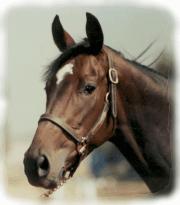
A Horse, of Course with Don Blazer |

If you enjoy learning about horses, then you'll love
our Community College online Personal Enrichment courses. Each month you'll find a new column on our web site. We hope you'll enjoy it, and maybe e-mail us with questions or suggestions for other columns. A Horse, Of Course is a monthly column syndicated by Success Is Easy. If you like the column, call your local newspaper, or local horse publication and ask them to subscribe by contacting Success Is Easy. |
The answers are in opposites. Training horses is very simple and very complicated. Before you start you ought to know the horse's natural instincts in order of significance. You ought to have a basic understanding of behavior modification techniques, such as "flooding" or "successive approximation", and you ought to know how to substitute for a "primary motivator." You ought to know the correct definition of the bit being used, and how it works. You ought to know if your saddle fits. You ought to know where you want the horse to put his feet so no matter the exercise, he remains balanced and isn't being subjected to unnecessary stresses. (Here's an opposite: in order for muscle or bone to be strong so it won't break down, it has to be weakened by moderate stress. It is not the stress that makes the bone stronger, however, it is the rest period (no stress) when the strengthening takes place. The same is true for muscles.) Before anyone attempts to train a horse, they ought to spend more money on education than they do chaps or English breeches.….but seldom is that the case. Here's an opposite; they try to teach something they haven't yet learned. Horse training can be complicated because it is so simple. The answers are in opposites. That single piece of information can make training quicker and easier for horse and rider. Example: if you want a horse to go forward slowly, get him to go backward quickly. That's the simplistic part of training…the complicated part is in knowing how to get him to go backward…and it has nothing to do with "pulling back on the reins." In fact, that's another opposite…when backing you don't want to "pull back on the reins"…you want to be squeezing with your legs as if you were going forward. The complicated part of training is in knowing how the horse's mind and body work so you can shift him to reverse gear. The greatest and most important element to training is an opposite--the "release." To communicate through the reins, you make contact with the bit in the horse's mouth and that creates discomfort, so the horse responds in a way the trainer hopes. But that doesn't train the horse; the training comes when and if the trainer "releases" the contact and restores comfort. It's the reward of being comfortable that teaches the horse the correct frame, or gait or movement. The pressure of leg, rein or bit causes an action; the release causes learning. Another opposite: most riders focus on trying to get perfect responses, perfect body position, perfect movement. They are always struggling to look perfect and be perfect. But it's the opposite that benefits the horse. If the rider focuses on the mistakes and correcting them, then teaching occurs. Stop trying to be perfect and be delighted with mistakes. Mistakes need to be understood so they can be avoided. To be perfect, avoid mistakes. Training horses would be simple if it wasn't so complicated. But once the complications are understood-the correct footfall sequence for a particular maneuver, for example-horse training becomes very simple. The rider correctly asks and the horse correctly responds. Of course, the law of opposites continues to hold true…if you want the horse to learn quickly…..go slowly. The highest levels of performance result from the mastery of a single step. The most unfortunate opposite: confrontation is a requirement of learning; therefore those who would train with only kindness and gentleness do the horse the greatest disservice. The horse does not learn from those he doesn't respect. Visit A Horse, Of Course on the Internet at www.donblazer.com |